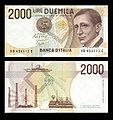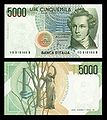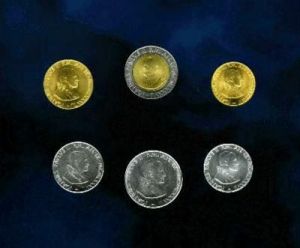ITL发表评论(0)编辑词条
Italian lira
Italian Lira (ISO code, ITL) was the currency of Italy between 1861
and 2002. Between 1999 and 2002, the Italian lira was officially a "national subunit" of the euro. However, physical payments could only be made in lire, as no euro coins and notes were available.
The lira was also the currency of the Napoleonic Kingdom of Italy between 1807 and 1814.
The term originates from the value of a pound weight (Latin: libra) of high purity silver and as such is a direct cognate of the British pound sterling; in some countries, such as Cyprus and Malta, the words lira and pound were used as
equivalents, before the euro was adopted in 2008 in the two countries. "L", sometimes in a double-crossed script form ("₤"), was usually used as the symbol. It was subdivided into 100 centesimi (singular: centesimo), which translates to "one hundredth".
Coins
Napoleonic Coins
The Napoleonic Kingdom of Italy issued coins between 1807 and 1813 in denominations of 1 and 3 centesimi and 1 soldo in copper, 10 centesimi in 20%
silver alloy, 5, 10 and 15 soldi, 1, 2 and 5 lire in 90% silver and 20 and 40 lire in 90% gold. All except the 10 centesimi bore a portrait of Napoleon, with the denominations below 1 lira also showing a radiate crown and the higher denominations, a shield representing the various constituent territories of the Kingdom.
Kingdom of Italy, 1861-1946
In 1861, coins were minted in Florence, Milan, Naples and Turin in denominations of 1, 2, 5, 10 and 50 centesimi, 1, 2, 5, 10 and 20 lire, with the lowest four in copper, the highest two in gold and the remainder in silver. In 1863, silver coins below 5 lire were debased from 90% to 83.5% and silver 20 centesimi coins were introduced. Minting switched to Rome in the 1870s.
Apart from the introduction in 1894 of cupro-nickel (later nickel) 20 centesimi coins and of nickel 25 centesimi pieces in 1902, the coinage remained essentially unaltered until the First World War.
In 1919, with production of all earlier coin types except for the nickel 20 centesimi halted, smaller, copper 5 and 10 centesimi and nickel 50 centesimi coins were introduced, followed by nickel 1 and 2 lire pieces in 1922 and 1923, respectively. In 1926, silver 5 and 10 lire coins were introduced, equal in size and composition to the earlier 1 and 2 lire coins. Silver 20 lire coins were added in 1927.
In 1936, the last substantial issue of silver coins was made, whilst, in 1939, moves to reduce the cost of the coinage lead to copper being replaced by aluminium bronze and nickel by stainless steel. All issuance of coinage came to a halt in 1943.
Republic, 1946-2002
In 1946, coin production was resumed, although only in 1948 did numbers minted exceed 1 million. To begin with, four denominations were issued in aluminium, 1, 2, 5 and 10 lire. In 1951, the sizes of these four coins were reduced (although the 2 lire wasn't minted in 1951 or 1952) and in 1954-1955, an Acmonital (stainless-steel) 50 and 100 lire coins were introduced, followed by aluminium-bronze 20 lire in 1957 and silver 500 lire in 1958. Rises in the silver bullion price lead to the 500 lire coins being produced only in small numbers for collectors after 1967.
In 1977, aluminium-bronze 200 lire coins were introduced, followed in 1982 by the bi-metallic 500 lire. This was the first bi-metallic coin to be produced for circulation, minted using a system patented by IPZS. It was also the first to feature the value in braille.
Production of the 1 and 2 lire coins for circulation ceased in 1959; their mintage was restarted from 1982 to 2001 for collectors coin sets. Production of the 5 lire was highly reduced in the late 1970s and ceased for circulation in 1998. Analogously, in 1991 the producation for the 10 and 20 lire coins was limited. The sizes of the 50 and 100 lire coins were reduced in 1990 but were then increased somewhat in 1993. A bimetallic 1,000 lire coin was introduced in 1997 and stopped in 1998.
Coins still minted for circulation at the time of the changeover to euro were; in 2000 and 2001 only liras for collectors coins sets were minted.
• 10 lire
• 20 lire
• 50 lire (2.58 cent)
• 100 lire (5.16 cent)
• 200 lire (10.33 cent)
• 500 lire (25.82 cent)
• 1,000 lire (51.65 cent)
Banknotes
In 1882, the government began issuing small value paper money bearing the title "Biglietto di Stato". To begin with, there were 5 and 10 lire notes, to which 25 lire notes were occasionally added from 1895. The government also issued notes titled "Buono di Cassa" between 1893 and 1922 in denominations of 1 and 2 lire. Production of Biglietto di Stato ceased in 1925 but resumed in 1935 with notes for 1, 2, 5 and 10 lire being introduced by 1939.
The Bank of Italy began producing paper money in 1896. To begin with, 50,
100, 500 and 1,000 lire notes were issued. In 1918-1919, 25 lire notes were also issued but no other denominations were introduced until after the Second World War.
In 1943, the invading Allies introduced notes in denominations of 1, 2, 5, 10, 50, 100, 500 and 1,000 lire. These were followed in 1944 by a series of Biglietto di Stato for 1, 2, 5 and 10 lire, which circulated until replaced by coins in the late 1940s. In 1945, the Bank of Italy introduced 5,000 and 10,000 lire notes.
In 1951, the government again issued notes, this time simply bearing the title "Repubblica Italiana". Denominations were of 50 and 100 lire (replacing the Bank of Italy notes) and they circulated until coins of these denominations were introduced in the mid 1950s. In 1966, 500 lire notes were introduced (again replacing Bank of Italy notes) which were produced until replaced in 1982 by a coin.
意大利里拉(Italian Lira,原符号:Lit.标准符号:ITL)
意大利货币简史
意大利里拉:1808年,拿破仑一世命人在米兰铸造了第一枚里拉硬币,1862年8月24日,里拉成为意大利官方流通货币。里拉最早在意大利南部流通,后来才逐渐在意大利半岛上被广泛使用。里拉的名字来自拉丁文中的libra(磅),是古罗马的重量单位。
早期的意大利里拉是由政府和意大利中央银行分别发行,政府发行的只有500里拉券,1000里拉以上面额由中央银行发行。由于500里拉券已停止流通,里硬币代替,因此现行纸币只由中央银行发行。
由于意大利在第二次世界大战是战败国,所以第二次世界大战前发行的货币均已作废。战后发行过几版钞票,起初面额并不象现在这样大,由于主十年代以前的几次货币贬值,从六十年代后期开始发行50000、100000里拉,到1997年又发行了500000里拉的钞票,这是我国收兑的各国货币中面值最大的钞票。随着几次换版,八十年代以前发行的钞票均以停止流通。
近两年,由于假钞的出现,意大利银行又开始对50000里拉以上的钞票进行改版,但有所不同的是它并不是彻底换版,而是在原版的基础上改变颜色,增加防伪措施等。如:新版里拉增加了光变油墨,缩印文字,改变了安全线和对印等。
2002年02月28日起意大利里拉由欧元替代。
停止流通与收况期限
停止流通期限:2002.02.28,商业银行停止收兑期限:一般为2002.02.28,中央银行停止收兑期限:10年
意大利时拉币值与换算
纸币有:10,000、50,000、500,000、100,000、5,000、2,000、1,000里拉
硬币有: 20、50、100、200、500里拉
1ITL=100 centesimi(分)
意大利为里拉树碑
2002年1月1日开始,欧元代替12国货币,在欧盟的12个国家正式流通。像欧元区内其它11个国家的货币一样,意大利里拉将在经过两个月的过渡期后,正式从市场上消失。
意大利里拉自1862年首次在市场使用后,至今已经走过140个春秋。在这近一个半世纪中,围绕着它发生了多少人间的喜怒哀乐,现在它就要与人们告别了,人们还是有一种依依不舍之情,纷纷议论这最后一批里拉的“后事”,究竟如何来纪念它这不平凡的一生。最后意大利议会财经委员会提议,意大利集币协共和意大利新千年庆祝委员会主办,为意大利里拉树一尊纪念碑,让社会对里拉有一个永久的纪念。
据统计,现在在社会上流通的里拉仍然有35亿张纸币,另外在意大利中央银行的仓库中还存放着1亿张未上市的纸币。意大利中央银行估计,到2月28日里拉正式结束在市场上流通时,可能会回收到上述纸币的85%,其余的15%,一部分可能会在流通中被损坏,另一部分会被集币者收藏。从1月1日始,银行业务中对里拉是只收不出,流进银行的里拉纸币将打孔作废,不能再进入流通,将作为废纸送到专门废纸中心加工处理。废纸中心将根据不同面值而分类粉碎成纸屑,因币值不同而纸屑颜色也不同,1000里拉为灰色,5000里拉为绿色,10000里拉为兰色,50000里拉为红色,10万里拉为浅绿色,50万里拉为浅兰色。然后将这些纸屑挤压成长15厘米宽10 厘米高12厘米的本色砖块,交由慈善机构出售,所得收入归慈善机构(红十字会,联合国儿童基金会)所有。人们可以将这些由纸币屑制成的砖块拿来做镇纸或装饰,这种砖块一块相当于原来的700张纸币,币值相当于每块70万里拉至3亿5千万里拉不等。
除纸币外,社会上还流通着 39250吨硬币。从一月一日开始,这些硬币也将逐步回收。还在几年前人们就议论这些硬币如何处理,当时任国库部长的阿马托曾提出,用这些硬币建一个类似埃菲尔铁塔式的建筑。最后决定将回收后的硬币粉碎成金属碎屑,招标出售给一家冶金工厂,目前已经有10多家冶金厂提出竞标。这批硬币中,200里拉的硬币和双色硬币中的黄色部分将另有用场,即用来铸造一尊里拉纪念碑。现在已正式向意大利各界招标,包括海外的意大利侨民,参加者要在2002年3月底前将设计方案交给主办单位,然后由一个文化、艺术、经济、集币等各界人士组成的评审委员会投票确定最后方案。现在已经有一些城市提出申请,要求里拉纪念碑建在那里。
目前,人们难以想象这尊纪念碑会是什么模样,但有一点是可以肯定的,富有想象力的意大利人是不会辜负人们的期望的。这尊将要问世的里拉纪念碑将为已经十分丰富的意大利文化增添新的光彩。
与“ITL,意大利里拉,货币”相关的词条
→如果您认为本词条还有待完善,请 编辑词条
词条内容仅供参考,如果您需要解决具体问题
(尤其在法律、医学等领域),建议您咨询相关领域专业人士。
0

同义词: 暂无同义词
关于本词条的评论 (共0条)发表评论>>














